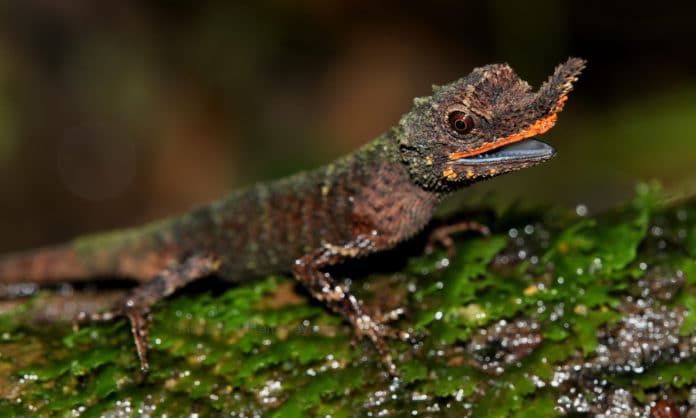Ceratophora Aspera, also known as rough-nosed horned lizards, are small rainforest lizards usually found in Sri Lankan rainforests. As their name suggests, they have a prominent horn in males.
In recent years, scientists are interested in conserving these rainforest lizards as the lizards are well-suited to understand the consequences of rainforest habitat destruction, climate change, and the pet trade.
By studying a specific type of mutations in the genome of these lizards, scientists could determine how geography and historical events impact the distribution of the remaining wild populations of rough-nosed horned lizards.
In a new study by the University of Washington, the UW Burke Museum of Natural History and Culture, WWF Hong Kong, and the University of Colombo have offered a vital road map to conserving rough-nosed horned lizards in Sri Lanka.
Scientists used a catch-and-release approach to obtain DNA from the rough-nosed horned lizards. The approach involves capturing wild lizards and taking tissue samples from the tips of their tails. Scientists took samples from across eight forests representing four forest groups from July through September 2018 and 2019.
Along with habitat destruction, these lizards are eaten by nonnative species like cats and chickens. Scientists recommend a conservation strategy that considers the population structure, history, and ecology of rough-nosed horned lizards to preserve genetic diversity.
Based on DNA analysis, rough-nosed horned lizards are separated by distance into four forest groups: Southern Lowlands, Sabaragamuwa Hills, Central Highlands, and Kithulgala.
With the Sri Lankan government pledging to reestablish rainforest natural surroundings, the outcomes from the study can assist with informing guidelines for forest landscape restoration. For instance, the similitudes in populaces and close geographic proximity between the lizards living in the Hiyare and Kottawa forest reserves in the Southern Lowlands forest group are extraordinary contenders for habitat restoration. The two populaces could be reconnected, expanding the odds for interbreeding, bringing about a stronger gene pool for future generations and less vulnerability to extinction.
Wikramanayake said, “I hope this study brings attention to the unique and obscure biodiversity in the rainforests of Sri Lanka that require urgent conservation action. It’s important to consider the genetic diversity in populations across their range when looking at conservation planning and strategies. This principle should also be considered in other forest ecosystems, where conservationists are planning restoration and habitat connectivity at landscape scales.”
Journal Reference:
- Shanelle A. Wikramanayake et al. Integration of genetic structure into the conservation of an endangered, endemic lizard, Ceratophora Aspera: A case study from Sri Lanka. DOI: 10.1111/btp.12970
